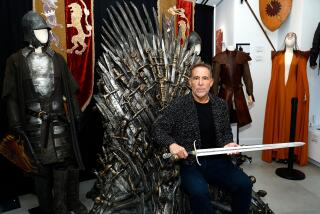An Offer You Should Refuse
- Share via
I couldn’t resist looking at the catalog for this week’s auction of Marlon Brando’s personal property at Christie’s. Although there are certainly some notable things for sale, including annotated copies of his scripts and letters to him from Francis Ford Coppola and Jack Kerouac, anyone looking at the catalog would have to acknowledge that the prices are awfully high for some pretty common junk.
Take Lot 156, for example: Brando’s bathroom scale. Christie’s expects it to sell for between $400 and $600. Or Lot 117, his car key ring (with the accompanying description, “the key ring used by Brando to hold his car keys”), which is expected to fetch between $300 and $500. Lot 155 is a used exercise bench. Price: $600 to $800. Each of these, needless to say, is well in excess of the typical price of a used version on EBay.
Why would people be willing to pay so much more than ordinary value for these items just because they were owned by someone famous? These are not autographs or historically significant accessories like Benjamin Franklin’s spectacles or FDR’s cigarette holder or even one of Michael Jackson’s gloves. These are just regular, commonplace things that happened to be hanging around Brando’s house.
An economist’s answer -- albeit one that completely begs the question -- would be that, hey, these are the preferences that buyers have and who are we to question the market? An auction, after all, is the classic free market. Items only sell for $500 if buyers bid them up to that level.
But, seriously, does a used exercise bench really deserve to go for three times what it would otherwise be worth just because Marlon Brando sat on it?
Certainly this is not the first time prices have been set at levels that struck ordinary people as exorbitant. Remember when the Tate Gallery in London paid more than $50,000 of British taxpayer money for a can of feces created and packaged by Italian artist Piero Manzoni (his work titled “Can 004”)? Just last month, someone paid almost $250,000 on EBay to purchase a 1999 VW Golf formerly owned by the pope. That’s at least 20 times the book value.
Then there was the dress in which Marilyn Monroe sang “Happy Birthday” to President Kennedy at a show in Madison Square Garden in 1962. It sold for $1.2 million at an auction at Christie’s in 1999.
Perhaps the explanation for these extraordinary prices is rank sentimentality. Or perhaps our culture of celebrity adds so much cache these days that it can be measured in dollars.
But if you are a Brando buff, before you go to New York to bid on a souvenir, make sure you aren’t doing it for the money. Collectibles are generally lousy investments. Yes, they can offer what economists call “non-pecuniary” benefits. (That is just a fancy way of saying that if people get a thrill from having a Brando key ring and showing it off to their friends, then that thrill is part of the “return” on the initial investment.)
But don’t count on returns of the old-fashioned variety -- of the sort you might expect from, say, a stock investment. The evidence is pretty overwhelming that you shouldn’t buy Brando’s bathroom appliances for the financial return.
And even if there is a potential financial return today, will it still be there tomorrow? Celebrity is fleeting, after all. Will Brando still be famous in 75 years?
Tom Mix was one of the biggest film stars of the 1920s. Today he may be best known for the “Tom Mix Celebrity Outhouse” in Driftwood, Pa. A poke around the Internet shows that you can buy a piece of Elvis’ hair, a dress worn by Audrey Hepburn or a tile from Marilyn Monroe’s shower, each for less than $100. So is there really any reason to believe that Brando’s exercise bench will hold its value?
If you must bid at Thursday’s auction, try to be judicious. Occasionally there are bargains to be had for those who watch closely. Take Lot 198: Brando’s 1992 Lexus LS400 (“White with tan leather interior, just under 75,000 miles, with Nakamichi sound system, hard-wired cellphone, with tinted windows”). The Lexus is expected to sell for $4,000 to $6,000. But the blue book value for the same car is $6,255.
That certainly beats the deal for the pope’s VW. On the other hand, as my father-in-law always says, when you buy someone’s car you’re buying their problems. Did Brando take care of that car?






